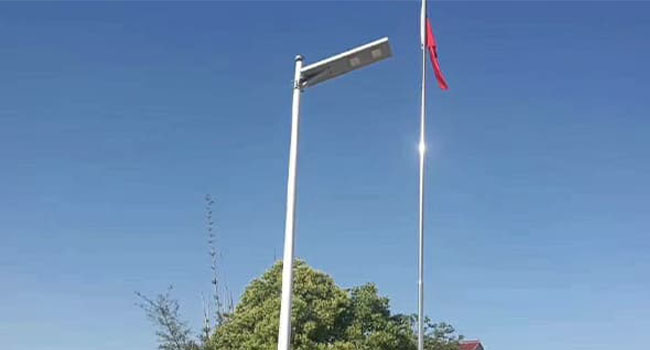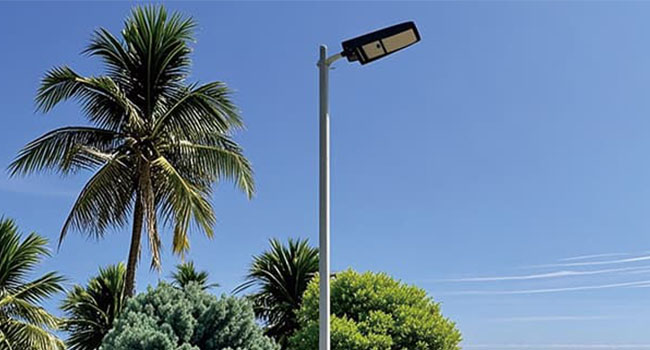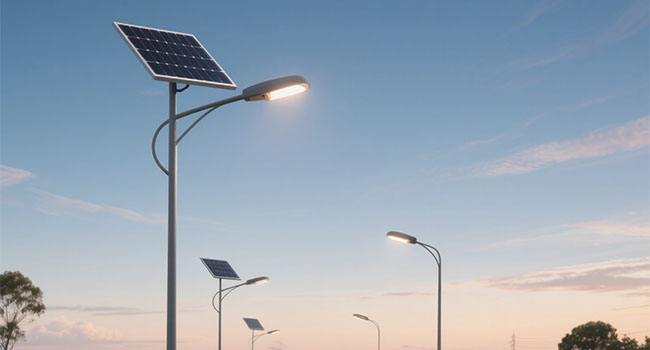Several things you need to know about LED Street Light
In the world actively practicing energy saving and emission reduction and the pursuit of green development, the lighting field is experiencing a far-reaching change. Solar LED street lights, as the dazzling stars of this change, with their unique technical advantages and environmental characteristics, are gradually rewriting the night lighting pattern of cities and villages. From the main roads of busy cities to the winding paths of quiet villages, solar LED street lights can be seen everywhere, which not only light up the roads at night but also bring bright hope for a sustainable future. Let's delve deeper into the mysteries of solar-powered LED street lights and learn all the key information you need to know.

What Are the Advantages of Solar Powered Street Lights?
Energy Sustainability
Solar energy, as a kind of clean energy, is inexhaustible. Solar LED street lights rely on solar panels to collect solar energy and convert it into electricity to be stored for nighttime lighting. This means it greatly reduces the reliance on traditional non-renewable energy sources. In some remote mountainous areas or off-grid regions, where laying the grid is costly and difficult, solar street lights can get rid of grid restrictions and independently provide local lighting, solving the lighting problem.
Outstanding Cost-Effectiveness
Although the initial purchase and installation costs of solar street lights may be slightly higher compared to traditional street lights, this is mainly due to the investment in equipment such as solar panels, batteries, and related controllers. However, from the perspective of long-term operation, its advantages are very obvious. It does not need to pay electricity bills, which can save a lot of electricity expenses every year. And, because there is no complex wiring system, the probability of line failure is reduced, and maintenance costs are also reduced. For example, in some municipal lighting projects in some cities, after using solar street lights for many years, the savings in electricity and maintenance costs have far exceeded the initial cost of more investment.
Highly Environmentally Friendly
Solar street lights have no carbon emissions during operation and do not pollute the air, which is highly compatible with the green development concept advocated globally nowadays. It does not produce greenhouse gases like traditional street lights that use fossil energy to generate electricity. Moreover, its installation process has minimal interference with the ecological environment, whether in urban parks, nature reserves, or rural fields, can be well integrated, and will not damage the surrounding ecological landscape.
Convenient and Efficient Installation
The installation of solar street lights does not require large-scale digging and wiring work like traditional street lights. It can be installed in a shorter time, greatly shortening the construction period. At the same time, due to its high installation flexibility, it can be installed in different terrain areas according to the actual demand, such as hillsides, riversides, and other complex terrain, which is difficult to do with traditional street lights.
What Are the Disadvantages of Solar Street Lights?
Higher Upfront Cost
The upfront investment cost of solar street lights is relatively large, mainly due to the relatively high price of key components such as solar panels, batteries, and intelligent controllers. Taking a set of common specification solar street lights as an example, its purchase cost may be 30%–50% higher than that of traditional street lights with the same brightness. This may create some economic pressure for some projects with limited budgets.

Significantly Affected By Weather
The working efficiency of solar street lights is closely related to weather conditions. On rainy days, hazy days, and other insufficient light weather conditions, the charging efficiency of the solar panels will be significantly reduced, which in turn affects the lighting effect of the street lamp. In case of bad weather for many consecutive days, the stored battery power may not be able to meet the lighting demand for a long period of time, resulting in shorter lighting hours or lower brightness of the street light. For example, in some southern rainy season areas, continuous rainy weather will bring challenges to the use of solar street lights.
Limited Lighting Brightness and Duration
The lighting brightness and duration of a solar street light are constrained by the capacity of the battery and the efficiency of solar energy conversion. Generally speaking, the efficiency of solar panels in converting solar energy into electricity is between 15% and 20%. The size of the battery capacity determines the amount of stored power; if the battery capacity is small, even if fully charged under sufficient light, it may not be able to meet the demand for high-brightness lighting throughout the night. Different specifications of solar street lights have differences in lighting performance; some small solar street lights may only be able to meet the lower brightness and shorter duration of the lighting and cannot meet the traffic avenue and other places with high lighting requirements.
Which Sensor is Used in Solar Street Light?
Light Sensor
The light sensor is an extremely important part of solar street lights, and its working principle is to realize the automatic control of street lights by sensing the brightness of ambient light. When the ambient light becomes dark to a certain degree, the light sensor will trigger a signal to control the street light to turn on automatically, and when the light becomes bright during the day, it will turn off the street light automatically. This intelligent control not only realizes the unattended automatic operation of street lights but also effectively saves energy and avoids unnecessary power waste.
Human Infrared Sensor
Some high-end solar street lights are equipped with human infrared sensors. Its working principle is to detect the heat radiation emitted by the human body. When someone or a vehicle is active near the street light, the sensor detects the signal, and the street light will automatically increase the lighting brightness to provide a better lighting effect and protect the safety of pedestrians and vehicles. And when no one is active for a period of time, the street light automatically reduces the brightness and enters the energy-saving mode to further extend the battery usage time.
How Long Does It Take for A Solar Street Light to Charge?
Factors Affecting the Solar LED Street Light Charging Time
Solar panel power: The size of solar panel power directly affects the charging speed. The higher the power, the more electricity converted per unit time, and the faster the charging speed. For example, a 100W solar panel's charging speed will be significantly faster than a 50W solar panel's.
Light conditions: Light intensity and duration are key factors in determining the charging time. In sunny areas and hours, solar panels can get stronger light and charge faster, while on cloudy days with insufficient light or in winter with short light hours, the charging time will be longer.
Battery capacity: The size of the battery capacity is directly proportional to the charging time. Large-capacity batteries store more power and take longer to fill up. For example, a 100Ah battery takes much longer to charge than a 50Ah battery.

Solar Street Lights Common Charging Time Range
Under standard lighting conditions, i.e., a light intensity of 1000 W/m² and a temperature of 25°C, it takes about 8-10 hours for a 12 V, 100 Ah battery to be charged by a solar panel with a general power of 50 W. However, in actual scenarios, the charging time will fluctuate due to changing light conditions. In summer, when there is enough sunlight, it may take 6-8 hours to be fully charged, while in winter, when the light is weak, it may take 12-14 hours or even longer.
How Long Do Solar Street Lights Last?
Lifespan Analysis of Each Component
Solar panel: Under normal circumstances, the life span of a solar panel can reach 20-25 years. With the growth of the use of time, its conversion efficiency will gradually reduce, aging manifested in the surface yellowing, cracking, and other phenomena. Generally, after 10 years of use, the conversion efficiency may drop 10% - 15%.
Battery: The life of the battery mainly depends on its cycle charge and discharge times. Common lead-acid battery cycle charge and discharge times are 300-500, with a service life of about 3-5 years, while lithium battery cycle charge and discharge times are up to 1000-2000, with a service life of 5-10 years. When the battery reaches a certain number of times of charging and discharging, its capacity will be significantly reduced, affecting the lighting hours of street lights.Lamps and other electronic components: The service life of LED lamps is usually 50,000 - 100,000 hours, which is about 5 - 11 years. Other electronic components, such as controllers, have a normal life span of 5-8 years and may be shortened if they encounter abnormal conditions such as unstable voltage.
Factors Affecting the Overall Life
Environmental factors: temperature and humidity have a greater impact on the life of solar street light components. In a high-temperature environment, the chemical reaction inside the battery is accelerated, which will accelerate the aging of the battery, while in a humid environment, the electronic components are easy to be short-circuited by moisture, which will reduce the service life. For example, in high-temperature desert areas and humid coastal areas, the aging speed of solar street light components will be faster than in the general area.
Maintenance: Regular maintenance is crucial to extend the life of solar street lights. For example, regular cleaning of the solar panel surface dust can improve the charging efficiency; checking the battery electrolyte level and timely replenishment can ensure stable battery performance. If there is a lack of maintenance, the components of the street light may be damaged in advance due to dust accumulation, corrosion, and other problems.
Precautions to Take When Installing Solar Street Lights
Site Selection Points
Sufficient Light: When installing solar street lights, you should choose a location with sufficient light and no obstruction. Ensure that the solar panels can receive maximum sunlight during the day and avoid being blocked by buildings and trees. For example, when installing next to a city road, avoid the shaded areas of tall billboards and street trees.
Keep away from interference sources: Keep away from heat sources and strong electromagnetic interference sources. Heat sources will affect the performance of solar panels and batteries and shorten the service life; strong electromagnetic interference may affect the normal work of electronic components such as controllers, resulting in abnormal street light control. So you should avoid installing solar street lights near boiler rooms, substations, and so on.

Foundation Construction
Foundation Pouring: Foundation pouring should be carried out in strict accordance with the design requirements to ensure the solidity of the street light. The depth and size of the foundation should be determined according to the height and weight of the street light. Generally speaking, the depth of the foundation is 0.8-1.2 meters, and the length and width of the foundation should be increased according to the size of the street light base. During the pouring process, the strength and compactness of the concrete should be ensured to prevent problems such as voids and cracks.
Pre-embedded parts installation: the installation position and angle of the pre-embedded parts must be accurate. Pre-embedded parts are used to fix the street light pole; its installation is not standardized and will lead to street light pole tilt or even collapse. The installation should be measured and calibrated with a level or other tools to ensure that the embedded parts are horizontal and perpendicular to the ground, and at the same time, the embedded parts should be firmly fixed in the concrete foundation.
Component Installation and Connection
Solar Panel Installation: The installation angle of the solar panel is very critical and is usually adjusted according to the local latitude to ensure that the optimal light can be obtained in different seasons. Typical installation angles are between 30° and 60°. Make sure that the solar panels are securely fixed to avoid being blown off by the wind. At the same time, pay attention to the correct connection lines between the solar panels and the waterproof treatment in place to prevent rainwater from entering and causing short circuits.
Battery Installation: When installing the battery, pay attention to the correct connection of positive and negative poles to avoid damage to the battery by reversing the connection. After installation, the battery should be sealed and waterproofed to prevent rain erosion. Batteries can be installed in a specialized battery box, and desiccant can be placed in the box to maintain a dry internal environment.
Lamp installation: the installation height and angle of the lamps should be determined according to the lighting requirements. In road lighting, the lamps and lanterns installation height is generally 6-12 meters, and the angle should be able to cover the area that needs to be illuminated to avoid the emergence of lighting dead ends. During installation, make sure that the lamps and lanterns are firmly fixed and the lampshade is well sealed to prevent dust and rain from entering and affecting the lighting effect.
Commissioning and Testing
Commissioning Steps: After the installation is completed, carry out comprehensive commissioning. First of all, check whether the components are connected correctly and whether there are any broken lines, short circuits, or other problems. Then turn on the power and observe whether the solar panel is normally charged and whether the battery voltage is within the normal range. Finally, test the lighting function of the street light and check whether the light sensor and other intelligent control functions work normally.
Testing items and troubleshooting: Testing items include lighting brightness, lighting duration, charging efficiency, and so on. If the street light is found to have insufficient lighting brightness, it may be the failure of lamps or insufficient battery power; if the charging efficiency is low, it may be that the solar panel is dirty or there is a problem with the connection line. For different failure phenomena, it is necessary to investigate and solve them one by one to ensure that the solar street light can run normally and stably.
Solar street lights have a broad application prospect in the lighting field with their advantages of sustainable energy, cost-effectiveness, environmental friendliness, and convenient installation. However, we cannot ignore the disadvantages of high upfront costs, weather impacts, and lighting limitations. Understanding key information such as the sensors used in solar street lights, charging time, service life, and installation precautions is crucial for the proper selection, installation, and use of solar street lights. With the continuous progress and innovation of technology, it is believed that solar street lights will continue to overcome existing problems in the future and bring a more efficient and environmentally friendly lighting experience to our lives. We should continue to pay attention to and actively promote the development and application of solar street light technology.




